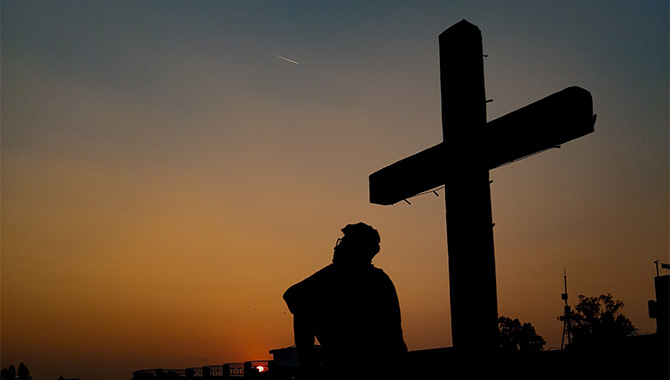June 6, 2021
Meanwhile, standing near the cross of Jesus were his mother, and his mother’s sister, Mary the wife of Clopas, and Mary Magdalene. ~ John 19:25
In 1987, an IRA bomb went off in a small-town west of Belfast. Eleven people died in the blast and sixty-three others were wounded. Gordon Wilson, a devout Methodist, was one of the wounded. The blast trapped Gordon and his twenty-year-old daughter beneath five feet of concrete and brick. Marie, his daughter was holding his hand as she said her last words, “Daddy, I love you very much.”
From his hospital bed Wilson told reporters, “I have lost my daughter, but I bear no grudge. Bitter talk is not going to bring Marie back to life. I will pray tonight and every night that God will forgive them.” His grace stopped extreme Protestants from detonating an “avenge” bomb. Wilson met personally with the IRA, forgave them, and asked them to lay down their arms.
“Love is the bottom line,” repeated Wilson. He held his pain and grief, let it transform him, and he returned kindness and love. Gordon Wilson dedicated the rest of his life to love and forgiveness. In 1995 when Wilson died, the Irish Republic, Northern Ireland, and all Great Britain honored this common human being with uncommon grace.
All healthy religions show us what to do with our pain says Richard Rohr. What do we do with our anger, our pain, our bitterness, and our resentment?
Father Ron Rolheiser and Rohr both say, “If we do not transform our pain, we will most assuredly transmit it.” You hit me so I will hit you back. You hate me so I will hate you back. We pass on our indignation usually to those closest to us, says Rohr: our family, our spouse, our neighbors, our co-workers, and, invariably, the most vulnerable, our children.
What do we do with our unresolved hurt?
On the cross Jesus says, “Father forgive them, they know not what they do,” (Luke 23:24). He steps out of the cycle of escalating rage and hostility and forgives. Jesus invites us to a higher place, a deeper maturity, a more intimate relationship with God and one another.
Christ invites us to meet hatred with love, bitterness with graciousness, jealousy with affirmation, and murder with forgiveness. This is the litmus test of walking the path of Jesus. As Rolheiser says, “Can we move beyond our natural instincts so as not to give back in kind? Can we love and forgive those whom we decide are not deserving of that grace?” Can we forgive ourselves and our transgressions? Can we forgive our nation and other nations?
“We shouldn’t try to get rid of our own pain until we’ve learned what it has to teach,” writes Rohr. Like Jesus on the cross, can we hold our pain, sit with it, learn from it, and not project it onto someone else or a group of people? Do we continue the cycle of blame, shame, and anger or do we step out of it and embrace the way of Grace?
The Reverend Dr. Martin Luther King famously said, “Darkness cannot drive out darkness, only light can do that. Hate cannot drive out hate, only love can do that.” Can we resist the temptation to give back in kind? How does it work out for us as individuals, a community, or a nation when we match or surpass the ill-will directed at us?
Mary gets it right. She stands at the foot of the cross in an image of “transformative spirituality.” As Rolheiser states, “On the surface it appears she is doing nothing. She does not speak. She does not try to stop the crucifixion. She does not protest the unfairness. She is mute, seemingly passive.” But, at a deeper level writes Rolheiser, she is holding and carrying the tension, the sorrow, and the pain. She refuses to give it back in kind.
Mary “stood” under the cross. In the gospels “standing” is a position of strength. Mary could have screamed hysterically, shouted angrily, or physically tried to attack someone who participated in the crucifixion of Jesus. If so, she would have been caught up in the same energy as everyone else, says Rolheiser. She would have replicated the same anger, bitterness, and violence which led to Jesus’ crucifixion. Mary lets her pain and grief transform her, so she embodies the peace, the gentleness, the forgiveness, and the light of Christ.
As Rolheiser states, “Mary says, ‘I can’t stop this crucifixion, but I can stop some of the hatred, bitterness, brutal heartlessness, and darkness that surround it.’” This is not hopelessness or resignation. Mary is part of a movement towards our Creator’s light, love, and peace on earth.
There are times to protest, to shout, to call out injustice but there are never times to be part of the loathing and violence. We let the rage and hatred soften our hearts not harden our hearts. We step out of the cycle of escalating violence and radiate “more respect than negative judgment, more empathy than anger, and more peace than hostility, and more joy than bitterness,” says Rolheiser. We stand at the foot of the cross with Mary.
Christ invites us to a more mature and abundant life. He invites us to hold and transform the ill will in our personal relationships, our communities, and our nations and to return light, love, and peace. We cannot change everything, but we can change, by the grace of God, our responses. We can refuse to give back in kind. We can be a sliver of light in the world.
Blessings and peace,
Craig

